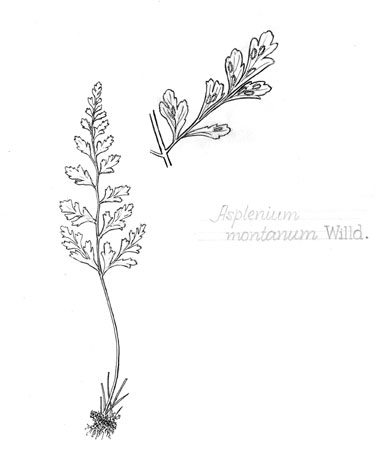| Asplenium montanum | ||
Mountain spleenwort | ||
|
Etymology
Montanum refers to the mountains.
Description
Rhizome: erect, occasionally branching, scales clathrate, to 3mm, dark brown.
Frond: 15 cm high by 5 cm wide, evergreen, monomorphic, blade/stipe ratio: 1:1 or less. Stipe: purple-brown at base, fading to green , dark brown, narrowly deltate scales at base grading into multicellular hairs, vascular bundles: 2 C-shaped, back to back, uniting to 1 upwards to an X-shape. Blade: 2-pinnate at the base, said to be occasionally more divided, always less upwards, oblong-triangular, leathery, dull, commonly with tiny glandular hairs and a few linear scales. Pinnae: 6 to 9 pair, opposite to alternate, anadromic, stemmed, variable in shape; margins serrate or creanate; veins free, forking. Sori: linear, along a vein, w-6 on each segment, indusium: translucent, pale tan, fimbriate, hidden by sporangia at maturity, on one side of the sorus, opening toward the middle of the segment, sporangia: brown. Culture
Habitat: crevices in sandstone or other acidic rocks.
Distribution: eastern United States.
Hardy to -30°C, USDA Zone 4.
|
|
|

Asplenium montanum, a dried specimen from Vinton County, Ohio. Jaknouse at Wikipedia |
